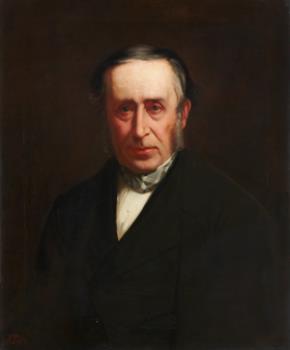- James Syme (1799-1870)
- ED.CS.2010.212
- James Syme (1799-1870), Fellow 1823, President 1849-1851 Oil on canvas, c.1860, by Sir George Reid (1841-1913) James Syme was born in Edinburgh. At the age of 18, he discovered a solvent for india-rubber and a process by which cloth might be impregnated with this substance making it waterproof. He published his discovery but a manufacturing chemist, Mr Macintosh of Glasgow, heard about it, took out a patent and made his fortune. Syme spent two years at arts classes at Edinburgh University before joining the anatomy class of John Barclay where Robert Liston was principal demonstrator. In 1822, he visited Paris to attend the classes of the famous surgeon, Dupuytren. He quickly made a reputation in Edinburgh as a surgeon, one of his early operations being the first amputation at the hip joint to be performed in Scotland. This and a celebrated excision of maxilla were both carried out in the 1820s, before the discovery of anaesthesia. In 1826, he applied for a post at Edinburgh Royal Infirmary but was turned down because of a quarrel he had with Liston. In consequence, he opened his own hospital, Minto House, which rapidly became a centre of excellence. In 1833, he was appointed as Professor of Clinical Surgery at Edinburgh University, his main rival for the post being Robert Liston, who was, two years later, offered the chair of clinical surgery at University College, London, which he accepted. When Liston died, Syme accepted that chair but he remained in London for only five months before returning to his Edinburgh chair which he held for 36 years. He had many assistants who went on to achieve fame but the most distinguished of them was Joseph Lister who became his son-in-law. An irascible man, Syme quarrelled at some time or another with most of his colleagues but he was idolised by his junior surgeons. He was an outstanding and bold surgeon - the ‘Napoleon of Surgery’. It was said of him by Dr. John Brown that he ‘never wasted a word, a drop of ink or a drop of blood’. Brown wrote a book, ‘Rab and his Friends’, which contains a description of Syme operating, without anaesthesia, on a woman in Minto House. He was President of the College from 1849 to 1851 and Surgeon to Queen Victoria. The Dutch tiles from Syme's retiring room in Minto House now adorn the fireplace in the Logan Turner room of the College building.
- Nineteenth century
- , Canvas
Height: Framed 100 cm
Width: 86.5 cm
Height: Canvas 74.8 cm










